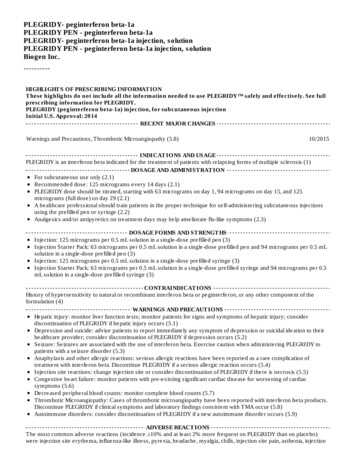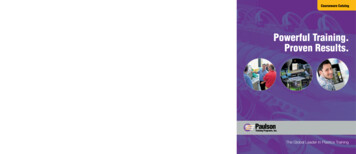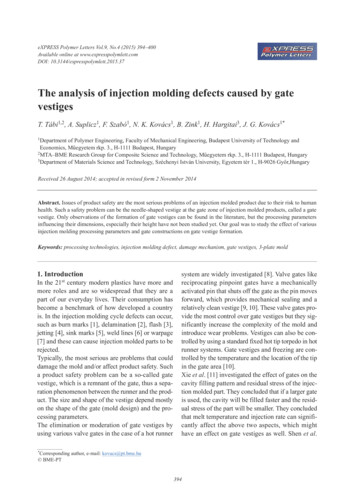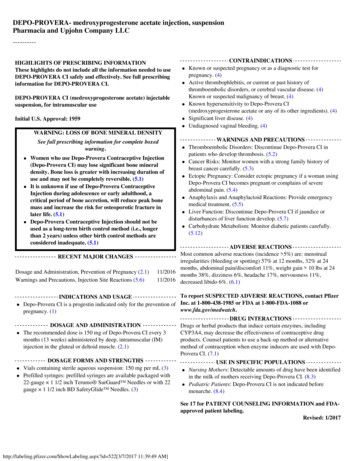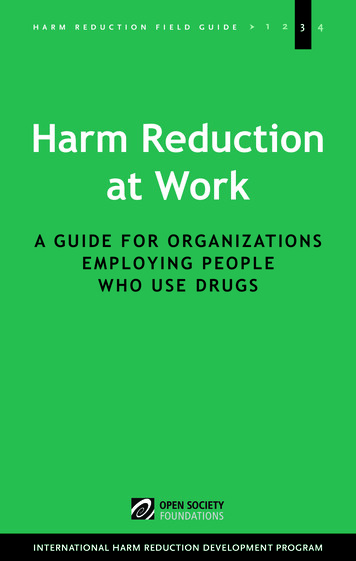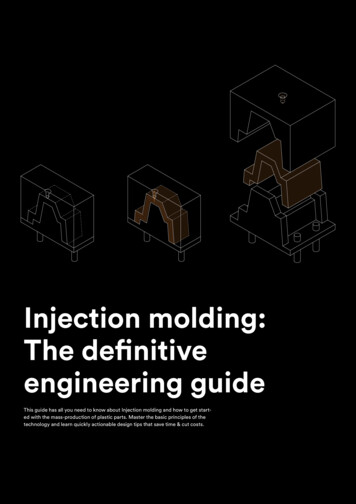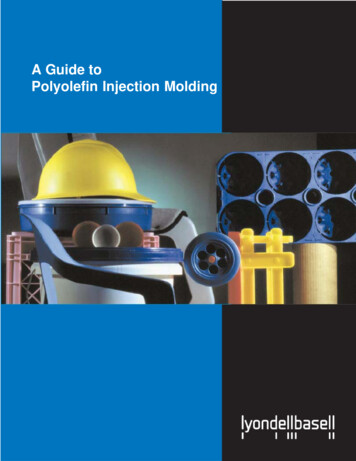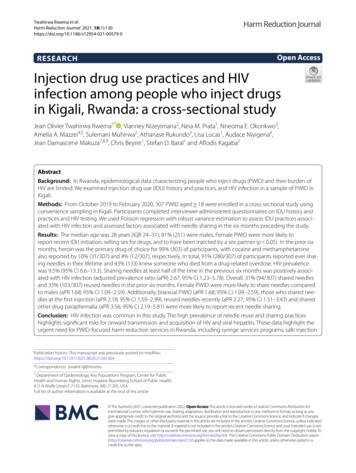
Transcription
Twahirwa Rwema et al.Harm Reduction Journal 2021, 0Open AccessRESEARCHInjection drug use practices and HIVinfection among people who inject drugsin Kigali, Rwanda: a cross‑sectional studyJean Olivier Twahirwa Rwema1* , Vianney Nizeyimana2, Neia M. Prata1, Nneoma E. Okonkwo3,Amelia A. Mazzei4,5, Sulemani Muhirwa2, Athanase Rukundo2, Lisa Lucas1, Audace Niyigena6,Jean Damascene Makuza7,8,9, Chris Beyrer1, Stefan D. Baral1 and Aflodis Kagaba2AbstractBackground: In Rwanda, epidemiological data characterizing people who inject drugs (PWID) and their burden ofHIV are limited. We examined injection drug use (IDU) history and practices, and HIV infection in a sample of PWID inKigali.Methods: From October 2019 to February 2020, 307 PWID aged 18 were enrolled in a cross-sectional study usingconvenience sampling in Kigali. Participants completed interviewer-administered questionnaires on IDU history andpractices and HIV testing. We used Poisson regression with robust variance estimation to assess IDU practices associated with HIV infection and assessed factors associated with needle sharing in the six months preceding the study.Results: The median age was 28 years (IQR 24–31); 81% (251) were males. Female PWID were more likely toreport recent IDU initiation, selling sex for drugs, and to have been injected by a sex partner (p 0.05). In the prior sixmonths, heroin was the primary drug of choice for 99% (303) of participants, with cocaine and methamphetaminealso reported by 10% (31/307) and 4% (12/307), respectively. In total, 91% (280/307) of participants reported ever sharing needles in their lifetime and 43% (133) knew someone who died from a drug-related overdose. HIV prevalencewas 9.5% (95% CI 6.6–13.3). Sharing needles at least half of the time in the previous six months was positively associated with HIV infection (adjusted prevalence ratio (aPR) 2.67; 95% CI 1.23–5.78). Overall, 31% (94/307) shared needlesand 33% (103/307) reused needles in the prior six months. Female PWID were more likely to share needles comparedto males (aPR 1.68; 95% CI 1.09–2.59). Additionally, bisexual PWID (aPR 1.68; 95% CI 1.09–2.59), those who shared needles at the first injection (aPR 2.18; 95% CI 1.59–2.99), reused needles recently (aPR 2.27; 95% CI 1.51–3.43) and sharedother drug paraphernalia (aPR 3.56; 95% CI 2.19–5.81) were more likely to report recent needle sharing.Conclusion: HIV infection was common in this study. The high prevalence of needle reuse and sharing practiceshighlights significant risks for onward transmission and acquisition of HIV and viral hepatitis. These data highlight theurgent need for PWID-focused harm reduction services in Rwanda, including syringe services programs, safe injectionPublication history: This manuscript was previously posted on medRxiv.https:// doi. org/ 10. 1101/ 2021. 08. 05. 21261 564.*Correspondence: jtwahir1@jhmi.edu1Department of Epidemiology, Key Populations Program, Center for PublicHealth and Human Rights, Johns Hopkins Bloomberg School of Public Health,615 N Wolfe Street E 7133, Baltimore, MD 21205, USAFull list of author information is available at the end of the article The Author(s) 2021, corrected publication 2022. Open Access This article is licensed under a Creative Commons Attribution 4.0International License, which permits use, sharing, adaptation, distribution and reproduction in any medium or format, as long as yougive appropriate credit to the original author(s) and the source, provide a link to the Creative Commons licence, and indicate if changeswere made. The images or other third party material in this article are included in the article’s Creative Commons licence, unless indicatedotherwise in a credit line to the material. If material is not included in the article’s Creative Commons licence and your intended use is notpermitted by statutory regulation or exceeds the permitted use, you will need to obtain permission directly from the copyright holder. Toview a copy of this licence, visit http:// creat iveco mmons. org/ licen ses/ by/4. 0/. The Creative Commons Public Domain Dedication waiver(http:// creat iveco mmons. org/ publi cdoma in/ zero/1. 0/) applies to the data made available in this article, unless otherwise stated in acredit line to the data.
Twahirwa Rwema et al. Harm Reduction Journal 2021, 18(1):130Page 2 of 11education, naloxone distribution, and substance use disorder treatment programs and optimizing these services tothe varied needs of people who use drugs in Rwanda.Keywords: People who inject drugs, HIV, Injection drug use, Kigali, RwandaIntroductionGlobally, 15 million people report injection drug use(IDU), with increasing numbers in countries across subSaharan Africa (SSA) [1, 2]. Estimates of IDU range from0.13 to 0.62% among the general adult population in SSA[1]. IDU is associated with an increased risk of acquiring HIV and other sexually transmitted infections (STIs),hepatitis B (HBV), hepatitis C (HCV), and other bloodborne infections (OBBI), and is associated with increasedburden of mental health disorders [2, 3]. The high risk ofHIV among PWID can be explained by individual factors like needle sharing, and structural factors including stigma and discrimination, criminalization, highexposure to human rights abuses; and a paucity of harmreduction programs [4, 5]. These structural-level factorslimit PWID engagement in prevention and treatmentservices, resulting in PWID having poorer HIV outcomescompared to other adults [6]. PWID additionally face significant social and economic challenges, as often demonstrated by their high burdens of homelessness, unstablehousing, and incarceration rates [1]. Finally, PWID haveoverlapping sexual risks with high levels of inconsistentcondom use and sex work [7].While the needs of PWID have been widely exploredand documented in high-income countries, limited dataexist for countries across SSA [1, 8]. However, a reviewof IDU in six African countries found a high prevalenceof high-risk behaviors including needle sharing andinconsistent condom use among PWID [9]. In additionto the paucity of evidence to guide programming, fewPWID-centered programs exist [8]. A systematic reviewof interventions to prevent and manage HIV and HCVamong PWID revealed that while more countries in SSAare studying drug use, few countries have increased theimplementation of PWID-focused programs over the lastdecade (2 to 7 for syringe programs, 4 to 8 for opioid substitution therapy, and even fewer for other interventions)[8]. Thus, more research among PWID is needed to guideimplementation across SSA.In Rwanda, HIV prevalence among reproductive agedadults has stabilized at 3% for the last decade, with thecountry being one of the few to achieve the UNAIDS90-90-90 HIV elimination targets by 2020 [10]. However, similar progress has yet to be seen among keypopulations (KPs). Recent studies have demonstrateda high prevalence of HIV and other STIs and programmatic gaps among KPs including Men who Sex with Men,Transgender Women, and Female Sex Workers [11–13].Moreover, PWID have been the most overlooked in HIVprogramming and research in Rwanda. Rwanda’s HIVguidelines have a minimum package of services for bothMSM and FSW, but no such program exists for PWID[14]. This lack of PWID-focused national programming,coupled with the criminalization of drug use, furthercomplicates programming in Rwanda [10]. Thus, understanding and addressing the needs of PWID in Rwanda isa public health and human rights imperative.We conducted this study to inform future researchand programming for PWID in Rwanda. The aim of thispaper was to estimate the burden of HIV infection and ofIDU practices among PWID in Kigali.MethodsStudy context, procedures, and populationThis was a cross-sectional mixed methods study implemented by Health Development Initiative (HDI), a localnongovernmental organization working with KPs inRwanda. This study leveraged qualitative and quantitativemethods to guide implementation of health programs forPWID in Rwanda. The specific objectives were to collectdata on sociodemographic characteristics and IDU practices among PWID, to characterize the PWID population, and to provide an estimate of the HIV prevalenceamong PWID in Kigali.Given the lack of a sampling frame and nonexistence ofreliable epidemiological or program data to guide probability sampling methods for PWID, study participantswere recruited through purposive and convenience sampling in Kigali city from October 2019 to February 2020.Initial participants were recruited from clients who useHDI clinical services in Kigali city. HDI offers a rangeof clinical services to members of different KPs. Clientswho reported injecting drugs recently, able, and willing toprovide informed consent were recruited into the study.Upon recruitment, these participants were trained andencouraged to recruit their own peers who injected drugsto the study. However, contrary to respondent-drivensampling, there was no maximum number of participants that individuals could recruit. Further communityoutreach was conducted by HDI community liaisonsto recruit more PWID from all three districts of Kigali:Nyarugenge, Kicukiro, and Gasabo. Eligible participantswere at least 18 years old, had injected drugs in the sixmonths preceding the study, agreed to be tested for HIV,
Twahirwa Rwema et al. Harm Reduction Journal 2021, 18(1):130and gave written consent to participate in the study. Thestudy was approved by the Rwanda National Ethics Committee N: 027/RNEC/2020.Data collectionData collection was conducted in two HDI sites in Kigalicity. After signing the informed consent form, participants underwent structured face-to-face interviewsconducted by trained data collectors and biological testing for HIV. The questionnaire comprised of questionsrelated to sociodemographic characteristics and IDUhistory and practices in the months preceding the study.Participants were also asked about their need for, andaccess to, substance use disorder treatment programs.No additional personal identifying information was collected other than the signature on the written informedconsent.We performed HIV rapid testing for all participantswho gave consent, per the national guidelines [14]. Thescreening test was Alere HIV Combo-Determine (Alere,Inc, Waltham, MA), and the confirmatory test wasHIV1/2 STAT-PAK (Medford, NY, USA). Participantswith a prior documented HIV diagnosis in a health facility were not retested. Participants who were newly foundto be living with HIV were referred to a healthcare facility to initiate antiretroviral treatment (ART) and for further medical management. Participants also receivedinformation on centers providing substance use disorder treatment in Rwanda. Upon completion of studyprocedures, participants received 2000 Frw as transportreimbursement.Outcome assessmentThe primary outcome was prevalent HIV infection. HIVpositive status was based on testing conducted in thestudy or previously medically confirmed HIV-positivestatus. The second outcome was self-reported recent needle sharing (i.e., six months prior to study enrollment).Other variables of interestSociodemographic characteristicsSociodemographic characteristics included age, sexassigned at birth, education, occupation, and sexualorientation.Age was collected as a continuous variable but categorized into three groups for analytical purposes: 18–24,25–34, and 35 years. Sex was defined as female or malebased on sex assignment at birth. Sexual orientation wasself-reported and categorized as heterosexual, homosexual, and bisexual. Education and occupation wereanalyzed as categorical variables with three groups each(Table 1).Page 3 of 11IDU history and practices, access to treatment, and otherbehaviorsParticipants were asked the age at which they firstinjected drugs, the drug they first injected, source of thedrug, and whether they shared needles during their firstdrug injection. Overall injection history was assessed byestimating the duration of IDU for each participant andlifetime needle sharing history. Participants were alsoasked if they knew anyone who had died from a drugoverdose. Participants were asked detailed questionsabout their primary drug of injection, other drugs used,and frequency of drug injection in the prior six months.To assess injection frequency, participants were askedthe number of times they injected per day, week, month,or year. Frequency of needle sharing, sharing of otherinjection materials, and needle reuse were assessed using5-item scales ranging from never, rarely, half the time,most of the time, and always. Information on injectionpartnerships (i.e., sex partners, friends, relatives, drugdealer, strangers, or other) and history of exchanging sexfor drugs were also captured. Participants were askedabout their knowledge and use of substance use disordertreatment programs in Rwanda (Table 2). Finally, participants were asked questions assessing their HIV knowledge, HIV testing history, and condom use during sex.AnalysisWe calculated crude estimates, including means andproportions, for sociodemographic characteristics, theoutcomes of interest, and other covariates. Pearson’s Chisquared tests (χ2) were used to compare demographicand IDU behaviors by biological sex, and an alpha level of0.05 was used to attribute statistical significance.For both outcomes, we applied Lowess smoothed nonparametric regressions to choose appropriate scales forage and duration of injection drug use. For HIV infection,both variables showed an approximately linear association and were analyzed as continuous variables. However,they were not linearly associated with recent needle sharing and thus were analyzed as categorical variables in themodels for the second outcome. All other variables wereanalyzed as binary or categorical variables for both outcomes (Tables 3 and 4).Bivariable Poisson regression models with robust variance estimation were fitted to compute prevalence ratios(PR) and 95% confidence intervals (CI) determining theassociation between sociodemographic factors and IDUpractices for both outcomes. Poisson regressions wereused because both outcomes were common and log binomial models failed to converge. The final models for bothoutcomes were constructed using variables that wereassociated with the outcome if p 0.1 in the bivariable
Twahirwa Rwema et al. Harm Reduction Journal 2021, 18(1):130Page 4 of 11Table 1 Baseline characteristics of PWID in Kigali, Rwanda, N:307CharacteristicN%Not living with HIVN (%)Living with HIVN (%)Age in years*18–248327.280 (96.4)3 (3.6)25–3418861.6167 (88.8)21 (11.2)3411.230 (88.2)4 (11.8) 35Biological sexFemale5618.248 (85.7)25181.8230 (91.6)Primary education or less4715.340 (85.1)Some secondary education7925.776 (96.2)3 (3.8)18158.9162 (89.5)19 (10.5)Male8 (14.3)21 (8.4)EducationCompleted secondary or above7 (14.9)Marital status**Single25282.9232 (92.1)20 (7.9)Cohabitating/Married3310.831 (93.9)2 (6.1)Divorced/Separated/Widow196.312 (63.2)7 (36.8)OccupationUnemployedStudent16955154 (91.1)15 (8.9)103.310 (100)12841.7114 (89.1)14 (10.9)Heterosexual21570.3198 (92.1)17 (7.9)Homosexual3511.431 (88.6)4 (11.4)Bisexual5618.348 (85.7)8 (14.3)Part time/Full time employee0 (0)Self-reported sexual orientation**** Data missing for n 2; **Data missing for n 3; *** Data missing for n 1analyses. Sex and age were included in the final multivariable models irrespective of their associations with theoutcomes in the bivariable analyses. Analyses were performed with Stata version 14.2 (StataCorp, College Station, TX) statistical package.ResultsSociodemographic characteristics and HIV infectionOverall, 322 PWID were recruited, but analyses wererestricted to 307 participants for whom HIV status information was available (five participants refused testingand 10 were missing testing results). The median age ofparticipants was 28 years (IQR:24–31), and 81% (248)were males (Table 1).The prevalence of HIV in this group was 9.5% (95% CI8.7–9.3).Injection drug use history and practicesMedian age at first injection was 23 (IQR 20–27), but 17%(53) of participants had their first injection before reaching 18. The majority of participants, 57% (176), had beeninjecting for four or more years. Nearly all, 99% (304),injected heroin their first time.In the six months preceding the study, heroin was theprimary drug of choice for 99% (303) of participants.However, 10% (31) and 4% (12) also reported injectingcocaine and methamphetamine, respectively. Many participants, 30% (93), had used a drug combination in thesix months before the study. The most common combination of drugs was heroin and marijuana, reported by23% (70) of participants, while alcohol use was reportedin combination with heroin by 9% (28). IDU frequencywas high with 95% (293) of participants reporting at leastone injection per day in the previous six months.Overall, 31% (94) of participants reported recent needle sharing. However, up to 91% (280) of participantsreported ever sharing needles in their lifetimes. Furthermore, 33% (103) reported reusing needles in the previoussix months. Most participants, 98% (301), reported getting sterile syringes and needles from pharmacies and20% (61) reported also getting needles from their networks, including friends and sex partners. However, 34%(101) of participants reported inconsistent access to sterile needles for injection purposes.
Twahirwa Rwema et al. Harm Reduction Journal 2021, 18(1):130Page 5 of 11Table 2 Injecting drug use history and practices among PWID in Kigali, Rwanda, N:307VariableN%FemaleN (%)MaleN (%)p valueFirst drug injectionAge at first injectionLess than 185 (8.9)48 (19.1)18–241325317.34327 (48.2)105 (41.8) 2512239.724 (42.9)98 (39.1)0.187Drug injected the first timeHeroin30499.155 (98.2)249 (99.2)Cocaine20.61 (1.8)1 (0.4)Methamphetamine10.30 (0)1 (0.4)Self13443.721 (37.5)113 (45.1)Friend14647.517 (30.4)129 (51.4)206.516 (28.6)4 (1.6)72.32 (3.5)5 (1.9)No23476.243 (76.8)191 (76.1)Yes7323.813 (23.2)60 (23.9)25984.438 (67.8)221 (88.1)4113.416 (28.6)25 (9.9)Traded them for sex51.62 (3.6)3 (1.2)Refused to answer20.60 (0)2 (0.8)Less than 312942.332 (58.2)96 (38.6)4–5 years10534.418 (32.7)87 (34.9)7123.35 (9.1)66 (26.5)0.454Person who performed the injection the first timeSex partnerOther0.0001Needle sharing the first time0.913Source of drug the first timeBought them from someoneReceived them for free0.001Injecting drug historyDuration of drug injection*Over 50.007Needle sharing historyNever shared needles278.86 (10.7)21 (8.4)28091.250 (89.3)230 (91.6)No21269.545 (83.3)167 (66.5)Yes9330.59 (16.7)84 (33.5)Never21369.439 (69.6)174 (69.4)Rarely6019.58 (14.3)52 (20.7)Half of the time or more3411.19 (16.1)25 (9.9)Never20466.545 (80.4)159 (63.4)Rarely7524.48 (14.3)67 (26.7)Half of the time or more289.13 (5.3)25 (9.9)No20468.522 (39.3)182 (75.2)Yes9431.534 (60.7)60 (24.8)No12239.923 (41.1)99 (39.6)Yes18460.133 (58.9)151 (60.4)Ever shared needles0.575Used a Drug combination0.015Needle sharing in the previous six months0.285Needle reuse in the previous six months0.05Selling sex for Drugs in the previous six months*0.0001Need and access to substance use disorders treatment programsTried to reduce or quit drug consumption in the previous 6 months***Aware of any Drug addiction treatment programs0.839
Twahirwa Rwema et al. Harm Reduction Journal 2021, 18(1):130Page 6 of 11Table 2 (continued)VariableN%FemaleN (%)MaleN (%)p value0.285No20566.738 (67.9)167 (66.6)Yes4514.711 (19.6)34 (13.5)Don’t know5718.67 (12.5)50 (19.9)No29095.454 (96.4)236 (95.2)Yes144.62 (3.6)12 (4.8)No25984.449 (87.5)210 (83.7)Yes4815.67 (12.5)41 (16.3)Drug Addiction treatment in the previous six months****0.683Unable to access Drug Addiction treatment in the previous six months0.457Ever enrolled in a Drug Addiction treatment programNever been treated26385.751 (91.0)212 (84.5)Ever been treated216.83 (5.4)18 (7.2)Refused to answer237.52 (3.6)21 (8.3)0.395Bold values are for variables that were found to be statistically significantly different between male and female PWID* Data missing for n 2 ; ** Data missing for n 9 ; *** Data missing for n 1 ; **** Data missing for n 3There were several differences in IDU practicesbetween males and females. Females were more likelyto have been injected by a sex partner the first time (χ2p 0.007), to have recently initiated IDU (χ2 p 0.007),and to report selling sex for drugs compared to males(χ2 p 0.0001) (Table 2).Regarding HIV-related knowledge and behavior, 87%(268) reported knowing that IDU was a risk factor forHIV infection. Over half of participants, 65% (198),reported inconsistent condom use in the previous sixmonths.Factors associated with HIV infectionIn the final multivariable model, PWID who reportedsharing needles half the time or more in the six monthsprior to the study were more likely to be living withHIV compared to those who did not share needles(adjusted prevalence ratio (aPR) 2.67; 95% CI 1.23–5.78) (Table 3).Factors associated with recent needle sharingIn the multivariable analyses, several demographic andIDU variables were associated with recent needle sharing. Female PWID were more likely to share needlesduring drug injection compared to male PWID (aPR1.68; 95% CI 1.09–2.58). Additionally, bisexual individuals (aPR 1.48; 95% CI 1.03–2.07) were more likely thanheterosexual individuals to share needles.Regarding IDU history and practices, participantswho had shared needles during their first injectionwere more likely to have shared needles recently (aPR2.18; 95% CI 1.58–2.99). Furthermore, needle reuse(aPR 2.27; 95% CI 1.51–3.43) and sharing other druginjection equipment (aPR 3.56; 95% CI 2.19–5.81) werepositively associated with needle sharing (Table 4).DiscussionThis study is one of the first to characterize the population of PWID in Kigali and to describe the burden of HIVin this community. Moreover, it clearly demonstrates theexistence of individual risk factors in this population thatare known to be associated with HIV, including needlesharing and inconsistent condom use. These practiceshighlight substantial potential risks of onward transmission and acquisition of HIV and other blood-borne infections among PWID. These results show an urgent needfor implementation of evidence-based harm reductionstrategies and other individual-, network-, and structural-level interventions to reduce morbidity and mortality among PWID in Rwanda.In this convenience-based sample, PWID carried a disproportionate burden of HIV over three times what isobserved in the general population [15]. These findingsare consistent with other African studies, underscoring the need to address the HIV prevention and treatment needs of PWID [1]. However, some countries havereported higher HIV burden among PWID (e.g., Kenya14–20%; Mozambique 20–50%), likely reflecting theoverall higher burden of HIV in these countries compared to Rwanda [16–19]. Injection partners with whomone shares injection equipment often serve as a primarymode of HIV acquisition among PWID. However, risk
Twahirwa Rwema et al. Harm Reduction Journal 2021, 18(1):130Page 7 of 11Table 3 Factors associated with HIV infection among PWID in Kigali, Rwanda, N: 307N Living % Living Unadjusted PR (95% CI) p value Adjusted PR (95% CI) p valuewith HIV with HIVSociodemographic characteristics1.05 (1.01–1.09)Age in years*0.020.98 (0.91–1.07)0.8420.1691.86 (0.86–4.04)0.118Biological sexFemale814.3218.4Primary education or less714.9Some secondary education33.81910.5MaleRef0.58 (0.27–1.25)EducationCompleted secondary or aboveRefRef0.25 (0.07–0.94)0.040.29 (0.09–1.04)0.060.71 (0.31–1.57)0.3950.64 (0.27–1.39)0.239Marital status**Single207.9RefCohabitating/Married26.10.76 (0.18–3.13)0.708Ref0.75 (0.21–2.74)0.67Divorced/Separated/Widow736.84.64 (2.25–9.58)0.0013.86 (1.49–10.01)0.0051.04 d1410.9Ref1.23 (0.62–2.46)0.554Self-reported sexual .44 (0.52–4.05)0.484Bisexual814.31.81 (0.82–3.97)0.141Before 18 years59.418 to 24 years129.11.36 (0.57–3.23)0.48Over 25 years129.81.82 (0.75–4.37)0.1831.06 (0.99–1.11)0.055Drug Injection related behaviors, access to needles andcondom useAge at first injectionRefDuration of drug injection****Years injecting drugsNeedle sharing in the previous 6 monthsNever15Rarely6107.1Ref1.42 (0.57–3.51)0.447Ref1.31 (0.44–3.93)0.625Half the time or more823.53.34 (1.53–7.28)0.0022.77 (1.28–5.98)0.009RefNumber of needles sharing partners in the previous6 monthsNone711.1158.20.74 (0.31–1.73)0.484715.91.43 (0.54–3.79)0.471No167.8Yes1313.81.76 (0.88–3.52)2010.2Ref98.90.87 (0.41–1.85)Always109.2RefNever or sometimes199.61.04 (0.50–2.17)One to twoThree or moreSelling sex for drugs in the previous 6 months*****Ref0.108Access to sterile needlesAlwaysSometimes0.723Condom use0.904Bold values are for variables that were found to be significantly associated with prevalent HIV infection* Data missing for n 2; ** Data missing for n 3; *** Data missing for n 1 ; **** Data missing for n 2 ; ***** Data missing for n 9
Twahirwa Rwema et al. Harm Reduction Journal 2021, 18(1):130Page 8 of 11Table 4 Factors associated with needle sharing in the six months preceding the study among PWID in Kigali, Rwanda, N: 307Shared needles% (N)Unadjusted PR (95% CI)p valueAdjusted PR (95% CI)p valueSociodemographic characteristics*18–2422.9 (19)Ref25–3432.9 (62)1.44 (0.92–2.25)0.108Ref1.01 (0.71–1.42)0.978 3538.2 (13)1.67 (0.93–2.99)0.0840.91 (0.57–1.45)0.698Male30.7 (77)RefFemale30.4 (17)0.98 (0.64–1.53)Primary education or less23.4 (11)RefSome secondary education21.5 (17)0 .92 (0.47–1.79)0.805Completed secondary or above36.5 (66)1.56 (0.89–2.71)0.116Single29.7 (75)RefCohabitating/Married33.3 (11)1.12 (0.66–1.88)0.669Divorced/Separated/Widow36.8 (7)1.24 (0.66–2.31)0.501Unemployed25.4 (43)RefEmployed/ Student36.9 (51)1.45 (1.03–2.04)Heterosexual27.4 (59)RefHomosexual28.6 (10)1.04 (0.58–1.84)0.8891.08 (0.75–1.55)0.667Bisexual44.6 (25)1.63 (1.13–2.34)0.0091.46 (1.03- 2.07)0.034Before 18 years30.2 (16)Ref18 to 24 years33.3 (44)1.10 (0.68–1.78)0.683Over 25 years27.9 (34)0.92 (0.56–1.52)0.754Less than 3 years20.3 (26)Ref4–5 years30.5 (32)1.50 (0.95–2.35)0.0771.05 (0.74–1.48)0.791Over 5 years50.7 (36)2.49 (1.65–3.77)0.0011.25 (0.83–1.89)0.281No15.4 (36)RefYes79.5 (58)5.16 (3.73–7.13)Biological sexRef0.9631.68 (1.09–2.59)0.019EducationMarital status**OccupationRef0.0311.58 (1.19–2.11)0.002Self-reported sexual orientation***RefDrug Injection related behaviors, access to needles and condom useAge at first injectionDuration of drug injection****RefNeedle sharing at the first injectionRef0.0012.18 (1.59–2.99)0.001Needle reuse in the previous 6 monthsNo9.8 (20)Yes71.8 (74)Ref7.32 (4.74–11.31)Two or less21.9 (54)RefMore than two partners90.9 (40)4.14 (3.21–5.34)Ref0.0012.27 (1.51–3.43)0.001Number of needles sharing partners in the previous 6 monthsRef0.0010.99 (0.79–1.25)0.983Selling sex for drugs in the previous 6 months*****No24 (49)Yes42.5 (40)Ref1.77 (1.26–2.48)Always19.4 (38)RefSometimes52.5 (53)2.71 (1.92–3.81)No19.4 (38)RefYes52.5 (53)9.38 (6.19–14.21)Ref0.0011.08 (0.79–1.46)0.607Access to sterile needlesRef0.0011.10 (0.84–1.44)0.477Sharing other drug paraphernalia in the previous 6 monthsRef0.001Bold values are for variables that were found to be significantly associated with needle sharing in the six months prior to the study* Data missing for n 2; ** Data missing for n 3; *** Data missing for n 1 ; **** Data missing for n 2 ; ***** Data missing for n 93.56 (2.19- 5.81)0.001
Twahirwa Rwema et al. Harm Reduction Journal 2021, 18(1):130of HIV and OBBI among PWID can be further compounded by sexual risk behaviors (e.g., condomless sex).Our results suggest that consistent condom use in thispopulation is low, which is expected given that researchsuggests riskier sexual practices are associated with substance abuse [20]. Globally, studies indicate that sexualrisks are elevated among PWID in countries across SSArelative to other regions, highlighting the importanceof understanding the intersecting impact of sexual andinjection drug risks among PWID in Rwanda [1]. Implementing sexual health programs, like condom distribution and HIV/STI management, could mitigate the addedsexual risks that PWID face. Successes of the RwandanHIV program in the general adult population could beleveraged to develop initiatives tailored to PWID needs.Importantly, we observed a high prevalence of riskyIDU practices. A high proportion of participantsreported reusing needles, which is known to be associated with severe infections including abscesses, septicemia, and infective endocarditis [21–23]. We also foundthat nine out of ten participants reported ever sharingneedles, while over one-third reported sharing needlesin the prior 6 months. Consistent with existing literature, needle sharing was positively associated with HIVinfection in this study [16, 17, 19]. Taken together, thesedata demonstrate the urgency for implementing comprehensive harm reduction interventions in Rwanda,particularly syringe service programs (SSP), to providesterile injection equipment and education on safer injection techniques [24]. Through provision of sterile needlesand other drug paraphernalia, SSPs have been shown toeffectively reduce unsafe injection practices and injectionfrequency, to facilitate linkage to substance use disordertreatment programs including medications for opioiduse disorder (MOUD) programs, and to be cost-effective [25–27]. Notably, we have found that female PWID,bisexual individuals, PWID who shared needles duringtheir first injection, those who reused needles recently,and those that share other drug injection paraphernaliahad higher proportions of needle sharing compared toothers. Consequently, careful consideration of these factors will be needed for optimal SSPs in Rwand
screening test was Alere HIV Combo-Determine (Alere, Inc, Waltham, MA), and the conrmatory test was HIV1/2 STAT-PAK (Medford, NY, USA). Participants with a prior documented HIV diagnosis in a health facil-ity were not retested. Participants who were newly found to be living with HIV were referred to a healthcare facil-


